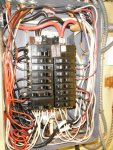tonype
Senior Member
- Location
- New Jersey
Bottom fed panel to main lugs - 100-amp main at top. The main lugs also supply a 2nd panel (right of photo). This panel has another 100-amp main at the top. Questions:
1. Isn't there an adaptor or similar fitting to use in lieu of the 2 cables on 1 lug?
2. The is no other main - doesn't this potentially create an overload condition on the conductors supplying the first panel?

1. Isn't there an adaptor or similar fitting to use in lieu of the 2 cables on 1 lug?
2. The is no other main - doesn't this potentially create an overload condition on the conductors supplying the first panel?


